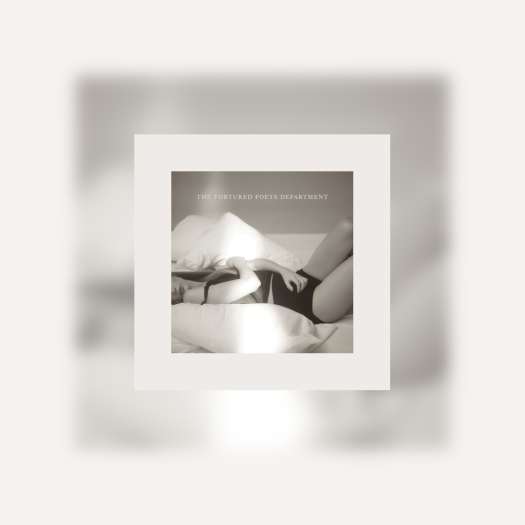If you weren't specifically looking for it, or didn't examine it closely, you likely wouldn't realize that Sampler 2: Art, Pop and Contemporary Music Graphics, the swift sequel to its 1999 namesake, is a book about album cover design. Which is perhaps an extension of the very point the book hopes to communicate: that art, specifically the often-belittled realm of commercial graphic design, is most alive when it defies convention. Confuses. Repels, even.
Sampler 2 seeks to demonstrate this is in the same two ways as its predecessor: visually (127 pages of avant-garde eye candy, including reproductions of CD and vinyl artwork for recordings by Primal Scream, Add N To (X), Chemical Brothers and Mouse On Mars), and verbally. The latter of these is what raises Sampler 2 above being merely a coffee table book for young urban hipsters. Adrian Shaughnessy, a principle of Intro, the London design firm that compiled the book, offers a passionate but balanced foreword that offers not only reference for the covers that follow, but extensive context as to how these covers represent a fundamental divide between corporate, mainstream record companies, and small, specialist independent labels. As much as major labels are now rarely interested in signing innovative, un-commercial artists, so too are they not going to commission design concepts offering anything other than airbrushed photos and the dullest of typefaces. "Nothing indicates more dramatically the creative stagnation of the mainstream record industry," Shaughnessy writes, "than the state of the record cover."
Although ostensibly written for other graphic designers, Sampler 2 should also be of interest to anyone who considers an album cover to be an essential part an overall sensory experience. Shaughnessy grapples with the ongoing debate as to whether any form of graphic design is actually art, or merely, according to the dissenting voices he dubs the "pragmatists," "a marketing tool, just another weapon in the armoury of companies fighting the pitched battles of modern commerce."
Shaughnessy is more on the side of the opposition, the Romantics, who believe that graphic design can be "a search for unformulaic expression an unwillingness to accept the role of the graphic designer as unquestioning servant of the modern consumerist society."
This sort of talk might seem heavy-going within the context of what should be a fun subject. But at a time when the enormity of mainstream popular culture is obscuring its smaller, innovative pockets more than ever, Shaughnessy's informed indignation is something for which anyone who cares about art should be grateful. And anyway, there's plenty of fun to be had in the pages that follow.
Any collection like this is bound to be subjective. Fortunately, Intro are obsessive music collectors, often buying releases for their covers alone. Among the relatively familiar likes of Xtrmntr and Cornelius's Fantasma, are striking but obscure packages from Cologne's Beige, and several releases on the Norwegian electronica label Rune Grammofon.
Intro don't appear to be interested in classicist styles. Everything here is virtually without precedent, distinguishing itself through sheer audacity. But it should be noted that technical complexity isn't a priority; good ideas count most, even if the point of some of those ideas is to be deliberately amateurish and crude. (Certainly, Intro's was the first voice from the design world to opine, in the original Sampler, how fresh and indelible Tortoise's hand-scribbled TNT cover is.) Many of the covers here address a retreat from the supposed "freedom" of computer design programs like Photoshop, which have created their own epidemics of conformity. The Magic Sound of Fenno'Berg, a CD collaboration by Christian Fennesz, Jim O'Rourke, and Peter Rehberg, features a grotesque but undeniably impressionable cut-and-paste collage of facial elements, creating a sort of monster-head. It could conceivably be the work of a grade-school art student, playful yet disturbing. hollAnd's Neoprene So Bright CD, and a 12" single by Skull Snapz, wield a similar aesthetic, combining unflattering amateur photography and near-illegible hand-scrawl that scans like anarchist graffiti in the alleyway beside a Backstreet Boys concert.
Textural manipulations feature here, too, although they translate less successfully to the printed page. If not for Shaughnessy's explanation, we wouldn't know that the sleeves of Icarus' UL-6 12-inch don't appear to be torn, but are, in fact, torn a humorous gesture meant to pre-empt the inevitable damage done to returned retail goods.
Where so many design books have an air of elitism about them, Sampler 2 is admirable for conveying, in its text and its visuals, the thrill of outsider culture, of pushing forward. Like good music, really.
Sampler 2 seeks to demonstrate this is in the same two ways as its predecessor: visually (127 pages of avant-garde eye candy, including reproductions of CD and vinyl artwork for recordings by Primal Scream, Add N To (X), Chemical Brothers and Mouse On Mars), and verbally. The latter of these is what raises Sampler 2 above being merely a coffee table book for young urban hipsters. Adrian Shaughnessy, a principle of Intro, the London design firm that compiled the book, offers a passionate but balanced foreword that offers not only reference for the covers that follow, but extensive context as to how these covers represent a fundamental divide between corporate, mainstream record companies, and small, specialist independent labels. As much as major labels are now rarely interested in signing innovative, un-commercial artists, so too are they not going to commission design concepts offering anything other than airbrushed photos and the dullest of typefaces. "Nothing indicates more dramatically the creative stagnation of the mainstream record industry," Shaughnessy writes, "than the state of the record cover."
Although ostensibly written for other graphic designers, Sampler 2 should also be of interest to anyone who considers an album cover to be an essential part an overall sensory experience. Shaughnessy grapples with the ongoing debate as to whether any form of graphic design is actually art, or merely, according to the dissenting voices he dubs the "pragmatists," "a marketing tool, just another weapon in the armoury of companies fighting the pitched battles of modern commerce."
Shaughnessy is more on the side of the opposition, the Romantics, who believe that graphic design can be "a search for unformulaic expression an unwillingness to accept the role of the graphic designer as unquestioning servant of the modern consumerist society."
This sort of talk might seem heavy-going within the context of what should be a fun subject. But at a time when the enormity of mainstream popular culture is obscuring its smaller, innovative pockets more than ever, Shaughnessy's informed indignation is something for which anyone who cares about art should be grateful. And anyway, there's plenty of fun to be had in the pages that follow.
Any collection like this is bound to be subjective. Fortunately, Intro are obsessive music collectors, often buying releases for their covers alone. Among the relatively familiar likes of Xtrmntr and Cornelius's Fantasma, are striking but obscure packages from Cologne's Beige, and several releases on the Norwegian electronica label Rune Grammofon.
Intro don't appear to be interested in classicist styles. Everything here is virtually without precedent, distinguishing itself through sheer audacity. But it should be noted that technical complexity isn't a priority; good ideas count most, even if the point of some of those ideas is to be deliberately amateurish and crude. (Certainly, Intro's was the first voice from the design world to opine, in the original Sampler, how fresh and indelible Tortoise's hand-scribbled TNT cover is.) Many of the covers here address a retreat from the supposed "freedom" of computer design programs like Photoshop, which have created their own epidemics of conformity. The Magic Sound of Fenno'Berg, a CD collaboration by Christian Fennesz, Jim O'Rourke, and Peter Rehberg, features a grotesque but undeniably impressionable cut-and-paste collage of facial elements, creating a sort of monster-head. It could conceivably be the work of a grade-school art student, playful yet disturbing. hollAnd's Neoprene So Bright CD, and a 12" single by Skull Snapz, wield a similar aesthetic, combining unflattering amateur photography and near-illegible hand-scrawl that scans like anarchist graffiti in the alleyway beside a Backstreet Boys concert.
Textural manipulations feature here, too, although they translate less successfully to the printed page. If not for Shaughnessy's explanation, we wouldn't know that the sleeves of Icarus' UL-6 12-inch don't appear to be torn, but are, in fact, torn a humorous gesture meant to pre-empt the inevitable damage done to returned retail goods.
Where so many design books have an air of elitism about them, Sampler 2 is admirable for conveying, in its text and its visuals, the thrill of outsider culture, of pushing forward. Like good music, really.




